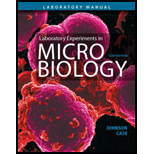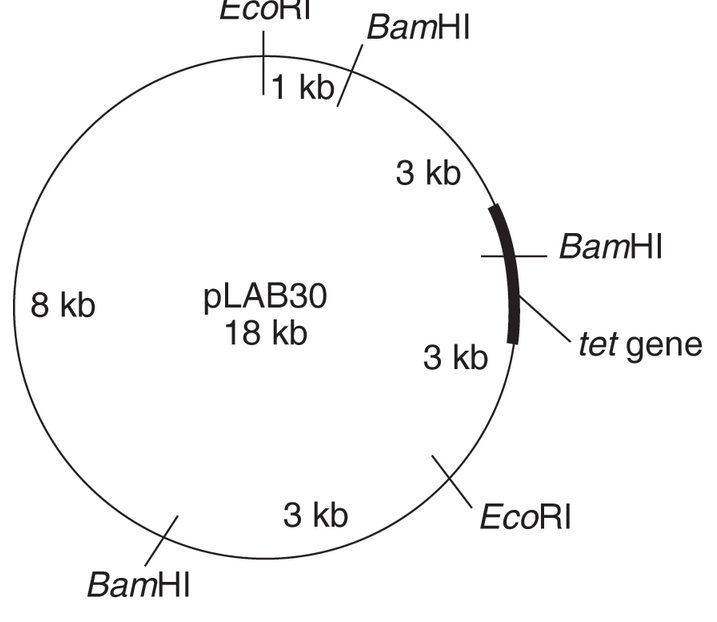
Concept explainers
Using this map of pLAB30 (18 kb), give the number and lengths of the restriction fragments that would result from digesting pLAB30 with EcoR1, with BamHI, and with both enzymes together.


Which enzyme will give the smallest piece containing the tetracycline-resistance gene?
To determine:
The size and number of DNA Fragments given by restriction enzymes Eco RI, Bam HI, and both these enzymes together.
Introduction:
Restriction enzyme is an enzyme that cuts the DNA fragment at the specific site by recognizing the DNA sequence at that site. The site at which the DNA is cut is termed as the restriction site.
Explanation of Solution
pLAB30 is an 18 kb map, which is cut by two restriction enzymes, Eco RI, and Bam HI. When Eco RI acts, then it cuts the DNA fragment at two sites, giving an 11 kb fragment and 7 kb fragment of the DNA.
When Bam HIacts, then it cuts DNA fragment at three sites, giving three fragments. The size of these fragments is 9 kb, 3 kb, and 6 kb.
When both these restriction enzymes act together, then 5 DNA fragments are obtained. The size of these fragments is 1 kb, 3 kb, 3 kb, 3kb, and 8 kb.
The table showing the size and number of DNA fragments after the DNA is acted upon by restriction enzymes is shown below:
| Restriction enzyme | Number of DNA fragments obtained | Size of DNA fragments |
| Eco RI | 2 | 11 kb and 7 kb |
| Bam HI | 3 | 9 kb, 3 kb, and 6 kb |
| Eco RI + Bam HI | 5 | 1 kb, 3 kb, 3 kb, 3kb, and 8 kb |
Want to see more full solutions like this?
Chapter 30 Solutions
Pearson eText for Laboratory Experiments in Microbiology -- Instant Access (Pearson+)
- Neurons and Reflexes 1. Describe the function of the: a) dendrite b) axon c) cell body d) myelin sheath e) nodes of Ranvier f) Schwann cells g) motor neuron, interneuron and sensory neuron 2. List some simple reflexes. Explain why babies are born with simple reflexes. What are they and why are they necessary. 3. Explain why you only feel pain after a few seconds when you touch something very hot but you have already pulled your hand away. 4. What part of the brain receives sensory information? What part of the brain directs you to move your hand away? 5. In your own words describe how the axon fires.arrow_forwardMutations Here is your template DNA strand: CTT TTA TAG TAG ATA CCA CAA AGG 1. Write out the complementary mRNA that matches the DNA above. 2. Write the anticodons and the amino acid sequence. 3. Change the nucleotide in position #15 to C. 4. What type of mutation is this? 5. Repeat steps 1 & 2. 6. How has this change affected the amino acid sequence? 7. Now remove nucleotides 13 through 15. 8. Repeat steps 1 & 2. 9. What type of mutation is this? 0. Do all mutations result in a change in the amino acid sequence? 1. Are all mutations considered bad? 2. The above sequence codes for a genetic disorder called cystic fibrosis (CF). 3. When A is changed to G in position #15, the person does not have CF. When T is changed to C in position #14, the person has the disorder. How could this have originated?arrow_forwardhoose a scientist(s) and research their contribution to our derstanding of DNA structure or replication. Write a one page port and include: their research where they studied and the time period in which they worked their experiments and results the contribution to our understanding of DNA cientists Watson & Crickarrow_forward
- hoose a scientist(s) and research their contribution to our derstanding of DNA structure or replication. Write a one page port and include: their research where they studied and the time period in which they worked their experiments and results the contribution to our understanding of DNA cientists Watson & Crickarrow_forward7. Aerobic respiration of a protein that breaks down into 12 molecules of malic acid. Assume there is no other carbon source and no acetyl-CoA. NADH FADH2 OP ATP SLP ATP Total ATP Show your work using dimensional analysis here: 3arrow_forwardFor each of the following problems calculate the following: (Week 6-3 Video with 6-1 and 6-2) Consult the total catabolic pathways on the last page as a reference for the following questions. A. How much NADH and FADH2 is produced and fed into the electron transport chain (If any)? B. How much ATP is made from oxidative phosphorylation (OP), if any? Feed the NADH and FADH2 into the electron transport chain: 3ATP/NADH, 2ATP/FADH2 C. How much ATP is made by substrate level phosphorylation (SLP)? D. How much total ATP is made? Add the SLP and OP together. 1. Aerobic respiration using 0.5 mole of glucose? NADH FADH2 OP ATP SLP ATP Total ATP Show your work using dimensional analysis here:arrow_forward
- Aerobic respiration of one lipid molecule. The lipid is composed of one glycerol molecule connected to two fatty acid tails. One fatty acid is 12 carbons long and the other fatty acid is 18 carbons long in the figure below. Use the information below to determine how much ATP will be produced from the glycerol part of the lipid. Then, in part B, determine how much ATP is produced from the 2 fatty acids of the lipid. Finally put the NADH and ATP yields together from the glycerol and fatty acids (part A and B) to determine your total number of ATP produced per lipid. Assume no other carbon source is available. 18 carbons fatty acids 12 carbons glycerol . Glycerol is broken down to glyceraldehyde 3-phosphate, a glycolysis intermediate via the following pathway shown in the figure below. Notice this process costs one ATP but generates one FADH2. Continue generating ATP with glyceraldehyde-3-phosphate using the standard pathway and aerobic respiration. glycerol glycerol-3- phosphate…arrow_forwardDon't copy the other answerarrow_forward4. Aerobic respiration of 5 mM acetate solution. Assume no other carbon source and that acetate is equivalent to acetyl-CoA. NADH FADH2 OP ATP SLP ATP Total ATP Show your work using dimensional analysis here: 5. Aerobic respiration of 2 mM alpha-ketoglutaric acid solution. Assume no other carbon source. NADH FADH2 OP ATP Show your work using dimensional analysis here: SLP ATP Total ATParrow_forward
- Biology You’re going to analyze 5 ul of your PCR product(out of 50 ul) on the gel. How much of 6X DNAloading buffer (dye) are you going to mix with yourPCR product to make final 1X concentration ofloading buffer in the PCR product-loading buffermixture?arrow_forwardWrite the assignment on the title "GYMNOSPERMS" focus on the explanation of its important families, characters and reproduction.arrow_forwardAwnser these Discussion Questions Answer these discussion questions and submit them as part of your lab report. Part A: The Effect of Temperature on Enzyme Activity Graph the volume of oxygen produced against the temperature of the solution. How is the oxygen production in 30 seconds related to the rate of the reaction? At what temperature is the rate of reaction the highest? Lowest? Explain. Why might the enzyme activity decrease at very high temperatures? Why might a high fever be dangerous to humans? What is the optimal temperature for enzymes in the human body? Part B: The Effect of pH on Enzyme Activity Graph the volume of oxygen produced against the pH of the solution. At what pH is the rate of reaction the highest? Lowest? Explain. Why does changing the pH affect the enzyme activity? Research the enzyme catalase. What is its function in the human body? What is the optimal pH for the following enzymes found in the human body? Explain. (catalase, lipase (in your stomach),…arrow_forward
 Human Heredity: Principles and Issues (MindTap Co...BiologyISBN:9781305251052Author:Michael CummingsPublisher:Cengage Learning
Human Heredity: Principles and Issues (MindTap Co...BiologyISBN:9781305251052Author:Michael CummingsPublisher:Cengage Learning Biology Today and Tomorrow without Physiology (Mi...BiologyISBN:9781305117396Author:Cecie Starr, Christine Evers, Lisa StarrPublisher:Cengage Learning
Biology Today and Tomorrow without Physiology (Mi...BiologyISBN:9781305117396Author:Cecie Starr, Christine Evers, Lisa StarrPublisher:Cengage Learning Biology: The Dynamic Science (MindTap Course List)BiologyISBN:9781305389892Author:Peter J. Russell, Paul E. Hertz, Beverly McMillanPublisher:Cengage Learning
Biology: The Dynamic Science (MindTap Course List)BiologyISBN:9781305389892Author:Peter J. Russell, Paul E. Hertz, Beverly McMillanPublisher:Cengage Learning Concepts of BiologyBiologyISBN:9781938168116Author:Samantha Fowler, Rebecca Roush, James WisePublisher:OpenStax College
Concepts of BiologyBiologyISBN:9781938168116Author:Samantha Fowler, Rebecca Roush, James WisePublisher:OpenStax College Biology 2eBiologyISBN:9781947172517Author:Matthew Douglas, Jung Choi, Mary Ann ClarkPublisher:OpenStaxCase Studies In Health Information ManagementBiologyISBN:9781337676908Author:SCHNERINGPublisher:Cengage
Biology 2eBiologyISBN:9781947172517Author:Matthew Douglas, Jung Choi, Mary Ann ClarkPublisher:OpenStaxCase Studies In Health Information ManagementBiologyISBN:9781337676908Author:SCHNERINGPublisher:Cengage





